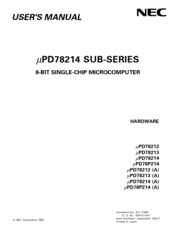NEC PD78214 Manuals
Manuals and User Guides for NEC PD78214. We have 1 NEC PD78214 manual available for free PDF download: User Manual
NEC PD78214 User Manual (487 pages)
8-BIT SINGLE-CHIP MICROCOMPUTER SUB-SERIES
Brand: NEC
|
Category: Computer Hardware
|
Size: 3.11 MB
Table of Contents
-
Fig. no20
-
Title, Page20
-
Table no29
-
Title, Page29
-
-
-
-
-
Notes64
-
-
-
Memory Space66
-
-
-
-
-
Notes133
-
-
-
PWM Pulse Output211
-
PWM Output211
-
-
-
Configuration234
-
Functions234
-
-
-
Notes241
-
-
-
Configuration254
-
-
Select Mode261
-
-
-
-
Scan Mode262
-
-
-
-
-
Configuration272
-
-
Transmission277
-
-
-
Reception278
-
Reception Error278
-
-
-
Function288
-
Configuration288
-
-
-
Address307
-
Command Signal307
-
-
Command and Data308
-
-
ACKT Operation310
-
ACKE Operations310
-
ACKD Operations311
-
BSYE Operation312
-
-
-
Read Timing377
-
Write Timing377
-
-
-
Wait Function386
-
-
Notes415
-
-
Reset Function418
-
-
-
Legend432
-
Operand Field432
-
Operation Field433
-
Flag Field434
-
-
-
-
B.1 Hardware460
-
B.2 Software462
-
-
Appendix E Index
476-
E.1 Index476
-
E.2 Symbol Index481
-
Advertisement
Advertisement
